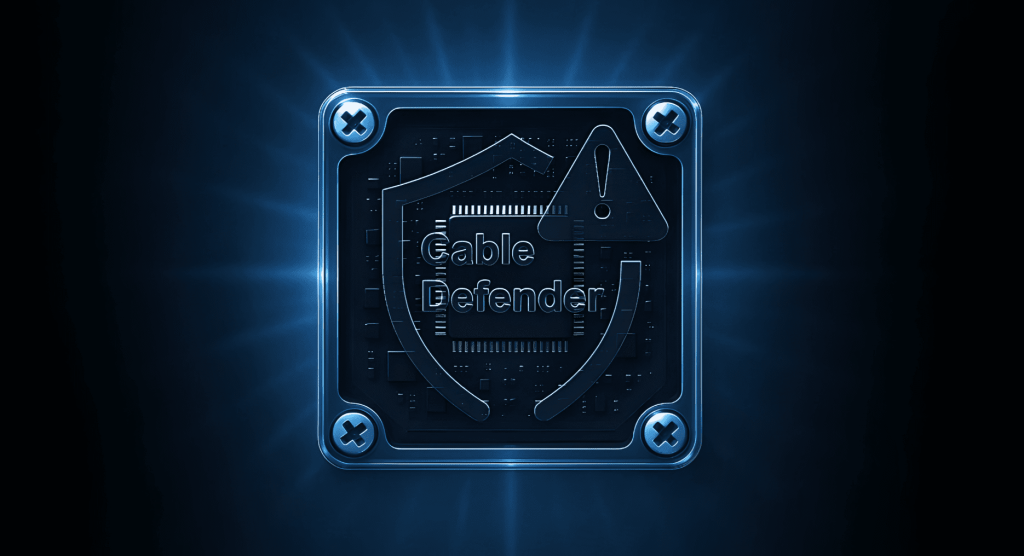How to Stop Copper Cable Theft & Cable Defender FAQs
Everything you need to know about how to stop copper cable theft, and how cable defender is the best choice in copper cable theft protection.
What is copper theft and why is it a problem?
Copper theft is the illegal removal of copper wiring or cabling, often from underground cable pits that house essential infrastructure like power, telecommunications, and traffic systems. Thieves target these pits because they are widely distributed, poorly monitored, and often contain high-value copper cables. This form of theft causes serious problems, including power outages, internet disruptions, and delays to critical services, while repair costs frequently run into the tens or hundreds of thousands of dollars per incident. The damage also poses safety risks to both the public and emergency responders, making it a major and growing concern for utilities, governments, and infrastructure operators.
Where is copper theft happening the most?
Copper theft is a growing global issue, with widespread incidents reported across Australia, the United States, and Europe. In Australia, police reports and utility providers continue to log rising cases of stolen cable from underground pits and roadside infrastructure. In the United States, cities such as Minneapolis, Dallas, and Los Angeles have become hotspots for theft from traffic systems, streetlights, and substations. Across Europe, copper theft is frequently reported on national rail networks, with delays caused by thefts in Germany, France, and the UK. Outside these regions, the problem is equally severe. South Africa’s railways and power stations face routine attacks, Canadian cities are responding to thefts from public lighting, and India’s railway signalling cables are regularly targeted. This widespread activity highlights that copper theft is not only persistent but expanding, with organised groups exploiting unmonitored copper cable installations around the world.
How much does copper theft cost and what is the financial impact?
Copper theft is inflicting significant financial damage across Australia, with costs escalating into the millions per state. In Queensland, incidents surged from 40 in 2017/18 to 170 in 2022/23, marking a 325% increase. Energy Queensland reports over $4.5 million annually in direct repair costs alone. In Western Australia, Main Roads WA estimates annual expenditures of $2–3 million to replace stolen cabling, with each incident potentially costing hundreds of thousands of dollars. Similarly, Telstra in the Northern Territory highlights that each theft incident costs tens of thousands of dollars, with total impacts running into the millions.
The financial burden extends beyond immediate repair costs. In Townsville, over a tonne of copper worth nearly $875,000 was stolen in less than two months, causing significant stress and financial strain on businesses. South Australia’s construction industry also faces substantial losses, with companies like Weeks SA reporting thefts costing well over six figures annually. Nationally, the Australian Institute of Criminology estimates the annual cost of metal theft at over $100 million.
Copper theft is a significant and costly issue in both the United States and Europe, causing extensive damage to infrastructure and incurring substantial financial losses. In the United States, copper theft costs businesses approximately $1 billion annually, impacting critical infrastructure such as electrical substations, railways, and telecommunications networks. For instance, in 2024, Lumen Technologies reported losses of $500,000 due to copper thefts in Washington state alone. In Minnesota, cities like Minneapolis and St. Paul have experienced significant repair costs, with Minneapolis allocating $1 million to address streetlight outages caused by copper theft.
In Europe, the situation is similarly dire. Germany’s Deutsche Bahn reported 450 cases of metal theft in 2023, resulting in approximately $8.1 million USD in damages and 40,000 minutes of train delays. France’s SNCF faced over $21.6 million USD in 2022 due to copper theft, affecting more than 40,000 trains. In the United Kingdom, copper theft led to 84,390 minutes of train delays in the 2022/23 financial year, costing approximately $15.5 million USD.
These figures underscore the urgent need for effective solutions to combat copper theft and mitigate its financial impact on infrastructure and services nationwide.
What are the best products and security systems to stop copper theft?
Many existing copper theft prevention systems are so costly and complex that it becomes nearly impossible to achieve a return on investment from the copper they aim to protect. Some solutions require running fiber-optic cable alongside copper lines and deploying specialized analyzers every 250 meters. This infrastructure is not only expensive to install but also difficult to maintain, especially across widespread networks. The cost of implementing such a system can easily exceed the value of the copper being protected, making it not financially viable for most councils, utilities, or infrastructure operators. These systems are especially impractical for small business owners who lack the resources to support such large-scale infrastructure.
Other systems use embedded copper pairs and powered transponders to detect tampering or breaks in the line. However, this method demands continuous power, regular diagnostics, and highly trained technicians for maintenance. The scale of investment needed to protect thousands of pits or cabinets using these methods makes them impractical for broad adoption.
Physical deterrents like lockable pit lids and reinforced enclosures are also widely used, but they offer limited protection. Thieves regularly bypass these barriers using common tools or simply move to nearby access points. In Queensland, for example, a 2023 government report noted that despite using upgraded lockable pit covers, “significant instances of theft were still occurring regularly across the network”. These lockable pit covers do not provide any real-time alerts, leaving critical infrastructure vulnerable and unsecured until after the damage is done. In another instance, Main Roads WA reported that thieves had stolen an estimated 15,000 metres of cabling from light poles along a path in the Perth suburb of Mirrabooka. Despite the use of lockable lids on the pits, the criminals managed to bypass these security measures, leading to significant costs and service disruptions.
In contrast, Cable Defender is specifically designed to overcome these challenges. It uses a battery-powered, wireless IoT sensor to monitor for tampering and pit access in real time without any need for fiber, external power, or complex infrastructure. Installation is simple, alerts are immediate, and the unit can operate for up to 10 years in the field. This makes Cable Defender the only copper theft prevention solution that is cost-effective, scalable, and suitable for widespread deploymen
How can I stop copper theft?
To stop copper theft, the best approach is to install Cable Defender in every copper cable pit. This system sends real-time alerts the moment a pit is opened without authorization, allowing for a fast response before any cables are stolen. Unlike physical barriers that can be cut or bypassed, Cable Defender is tamper-resistant and battery-powered, making it reliable even in remote areas. Installing the system across all access points helps prevent theft, reduce repair costs, and keep essential services running without interruption.
How does Cable Defender stop copper theft?
Cable Defender prevents copper theft by combining a tamper-resistant design with a battery-powered, wireless IoT sensor that detects unauthorized pit access and sends real-time alerts. Unlike traditional solutions that rely on complex and costly additional cable installations, constant calibration, or external power sources, Cable Defender is fully self-contained and easy to deploy in minutes. It operates on low-power cellular networks, eliminating the need for Wi-Fi or hardwired connections, and is built to withstand vandalism attempts. Designed for scalability, it can be installed across large infrastructure networks without the high costs or limitations of existing systems. This makes it ideal for councils, utilities, and contractors needing a reliable, long-term solution that works where others copper theft protection systems don’t.
Does Cable Defender work without Power or Wi-Fi?
Yes. Cable Defender devices are designed for easy install with minimal disruption to existing infrastructure. They use a 10 year battery and operate on low-power cellular networks like NB-IoT so it does not require power lines or internet cables. This makes it ideal for installation inside any existing cable pits, with an install time of under 5 minutes per cable pit.
How does Cable Defender detect and send alerts?
Cable Defender uses proprietary internal sensors to detect lid movement or cable pit access. Once triggered, it sends real-time copper theft alerts to our management platform. Using the SIA DC-09 standard alarm protocol over IP, alerts can then be sent to a third party alarm monitoring service. This allows for quick dispatch of security or police to the affected cable pits.
What is the battery life of Cable Defender?
Cable Defender devices use a lithium thionyl chloride (Li-SOCl₂) battery and are engineered for ultra-low power draw. Depending on the usage and signal strength, the battery life ranges from 10 to 13 years, making it ideal for long-term copper theft prevention with minimal maintenance.
How are Cable Defender devices managed once installed?
Cable Defender devices are managed through our central online platform that allows users to monitor status, receive real-time alerts, and assign maintenance with minimal effort. The system supports multiple user logins and integrates with third-party alarm monitoring. Designed for easy deployment and low upkeep, it ensures scalable, long-term protection with simple remote management.


The Best Solution to Prevent Copper Theft.
Detect intrusion the moment it happens & protect your infrastructure with Cable Defender. Instant wireless alerts when pits are opened – anywhere, anytime.
Cable Defender is a Division of Micro Connect,
Designed and Manufactured in Queensland, Australia.
With over 25 years of experience, Micro Connect specialises in the manufacture and deployment of enterprise-class data communications routing and wireless telemetry equipment, primarily serving government agencies.









